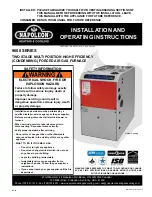
8
18-CD30D1-12
Installer’s Guide
OUTSIDE AIR IS RECOMMENDED
The use of indoor air for most applications is acceptable,
unless there is the presence of corrosive chemicals or
contamination. Certain types of installation will require
the use of outside air for combustion.
The following types of installations will
require
use
of
OUTDOOR AIR for combustion, due to chemical
exposures:
1. * Commercial buildings
2. * Buildings with indoor pools
3. * Furnaces installed in “confined” laundry rooms
4. * Furnaces installed in “confined” hobby or craft rooms
5. * Furnaces installed near chemical storage areas.
Exposure to the following substances in the combustion
air supply will also
require
OUTDOOR AIR for
combustion:
1. * Permanent wave solutions
2. * Chlorinated waxes and cleaners
3. * Chlorine based swimming pool chemicals
4. * Water softening chemicals
5. * Deicing salts or chemicals
6. * Carbon Tetrachloride
7. * Halogen type refrigerants
8. * Cleaning solvents (such as perchloroethylene)
9. * Printing inks, paint removers, varnish, etc.
10. * Hydrochloric acid
11. * Cements and glues
12. * Antistatic fabric softeners for clothes dryers
13. * Masonry acid washing materials
Furnace locations may be in a “
confined space
” or an
“
unconfined space
”.
Unconfined space
is defined in Figure 6. These spaces
may have adequate air by infiltration to provide air
for combustion and ventilation. Buildings with tight
construction (for example, weather stripping, heavily
insulated, caulked, vapor barrier, etc.), may need
additional air to be provided as described for
confined
space
. See Table 2 for minimum area.
The furnace must be supported at both ends and the
middle when installed horizontally. The furnace must
also be elevated approximately 4-6 inches to allow
clearance for the condensate drain to exit the cabinet
in the horizontal position.
The horizontal furnace may also be suspended from
the joists using all-thread rods with a substantial metal
support frame that supports the entire length of the
furnace. The rods need to be of sufficient length to
allow for proper clearances from combustible materials.
The frame needs to be at least 32" in length to allow for
access to service panels.
If the furnace is suspended using steel strap, it must be
supported at all four corners and in the middle at the front
of the furnace.
AIR FOR COMBUSTION AND VENTILATION
If these furnaces are installed in a nondirect vent capacity
then the adequate flow of combustion and ventilating
air must not be obstructed from reaching the furnace.
Air open ings provided for combustion air must be kept
free of obstructions which restrict the flow of air. Airflow
restrictions affect the efficiency and safe operation
of the furnace. Keep this in mind should you choose
to remodel or change the area which contains your
furnace. Furnaces must have a free flow of air for proper
performance.
Provisions for combustion and ventilation air shall be
made in accordance with latest edition of Section 5.3, Air
for Combustion and Ventilation, of the National Fuel Gas
Code, ANSI Z223.1 — CAN/CGA B149.1 or applicable
provisions of the local building codes. Special conditions
created by mechanical exhausting of air and fireplaces
must be con
sidered to avoid unsatisfactory furnace
operation.
50 CU. FT. OR MORE
PER 1000 BTU/HR. INPUT
ALL EQUIP. INSTALLED
UNCONFINED
6
5
UPFLOW/
HORIZONTAL
SHOWN WITH
DIRECT VENT
MINIMUM AREA IN SQUARE FEET
FOR UNCONFINED SPACE INSTALLATIONS
FURNACE MAXI-
MUM BTUH INPUT
RATING
WITH 8 FT. CEILING
MINIMUM AREA IN SQUARE FEET
OF UNCONFINED SPACE
60,000
80,000
100,000
120,000
375
500
625
875
TABLE 2









































